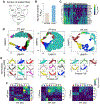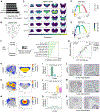A 3D transcriptomics atlas of the mouse nose sheds light on the anatomical logic of smell
- PMID: 35320714
- PMCID: PMC8995392
- DOI: 10.1016/j.celrep.2022.110547
A 3D transcriptomics atlas of the mouse nose sheds light on the anatomical logic of smell
Abstract
The sense of smell helps us navigate the environment, but its molecular architecture and underlying logic remain understudied. The spatial location of odorant receptor genes (Olfrs) in the nose is thought to be independent of the structural diversity of the odorants they detect. Using spatial transcriptomics, we create a genome-wide 3D atlas of the mouse olfactory mucosa (OM). Topographic maps of genes differentially expressed in space reveal that both Olfrs and non-Olfrs are distributed in a continuous and overlapping fashion over at least five broad zones in the OM. The spatial locations of Olfrs correlate with the mucus solubility of the odorants they recognize, providing direct evidence for the chromatographic theory of olfaction. This resource resolves the molecular architecture of the mouse OM and will inform future studies on mechanisms underlying Olfr gene choice, axonal pathfinding, patterning of the nervous system, and basic logic for the peripheral representation of smell.
Keywords: CP: Neuroscience; RNA-seq; machine learning; odorant; olfaction; olfactory epithelium; olfactory mucosa; spatial transcriptomics.
Copyright © 2022 The Authors. Published by Elsevier Inc. All rights reserved.
Conflict of interest statement
Declaration of interests The authors declare no competing interests.
Figures






Similar articles
-
Single-cell transcriptomics reveals receptor transformations during olfactory neurogenesis.Science. 2015 Dec 4;350(6265):1251-5. doi: 10.1126/science.aad2456. Epub 2015 Nov 5. Science. 2015. PMID: 26541607 Free PMC article.
-
Transcriptomes of mouse olfactory epithelium reveal sexual differences in odorant detection.Genome Biol Evol. 2012;4(5):703-12. doi: 10.1093/gbe/evs039. Epub 2012 Apr 17. Genome Biol Evol. 2012. PMID: 22511034 Free PMC article.
-
Overlapping but distinct topology for zebrafish V2R-like olfactory receptors reminiscent of odorant receptor spatial expression zones.BMC Genomics. 2018 May 23;19(1):383. doi: 10.1186/s12864-018-4740-8. BMC Genomics. 2018. PMID: 29792162 Free PMC article.
-
The sense of smell: molecular basis of odorant recognition.Biol Rev Camb Philos Soc. 2007 Aug;82(3):455-79. doi: 10.1111/j.1469-185X.2007.00019.x. Biol Rev Camb Philos Soc. 2007. PMID: 17624963 Review.
-
Genetics of canine olfaction and receptor diversity.Mamm Genome. 2012 Feb;23(1-2):132-43. doi: 10.1007/s00335-011-9371-1. Epub 2011 Nov 13. Mamm Genome. 2012. PMID: 22080304 Review.
Cited by
-
Opposing, spatially-determined epigenetic forces impose restrictions on stochastic olfactory receptor choice.Elife. 2023 Dec 18;12:RP87445. doi: 10.7554/eLife.87445. Elife. 2023. PMID: 38108811 Free PMC article.
-
Transcriptional priming and chromatin regulation during stochastic cell fate specification.Philos Trans R Soc Lond B Biol Sci. 2024 Apr 22;379(1900):20230046. doi: 10.1098/rstb.2023.0046. Epub 2024 Mar 4. Philos Trans R Soc Lond B Biol Sci. 2024. PMID: 38432315 Free PMC article. Review.
-
Epigenetic programming of stochastic olfactory receptor choice.Genesis. 2024 Apr;62(2):e23593. doi: 10.1002/dvg.23593. Genesis. 2024. PMID: 38562011 Free PMC article. Review.
-
Genomic snowflakes: how the uniqueness of DNA folding allows us to smell the chemical universe.Curr Opin Genet Dev. 2025 Jun;92:102329. doi: 10.1016/j.gde.2025.102329. Epub 2025 Mar 18. Curr Opin Genet Dev. 2025. PMID: 40107115 Review.
-
Exploring the latent space of transcriptomic data with topic modeling.NAR Genom Bioinform. 2025 Apr 22;7(2):lqaf049. doi: 10.1093/nargab/lqaf049. eCollection 2025 Jun. NAR Genom Bioinform. 2025. PMID: 40264683 Free PMC article.
References
-
- Achim K, Pettit J-B, Saraiva LR, Gavriouchkina D, Larsson T, Arendt D, and Marioni JC (2015). High-throughput spatial mapping of single-cell RNA-seq data to tissue of origin. Nat. Biotechnol 33, 503–509. - PubMed
-
- Aldinucci M, Bagnasco S, Lusso S, Pasteris P, Rabellino S, and Vallero S (2017). OCCAM: a flexible, multi-purpose and extendable HPC cluster. J. Phys. Conf. Ser 898, 082039.
Publication types
MeSH terms
Substances
Grants and funding
LinkOut - more resources
Full Text Sources
Molecular Biology Databases
Miscellaneous

